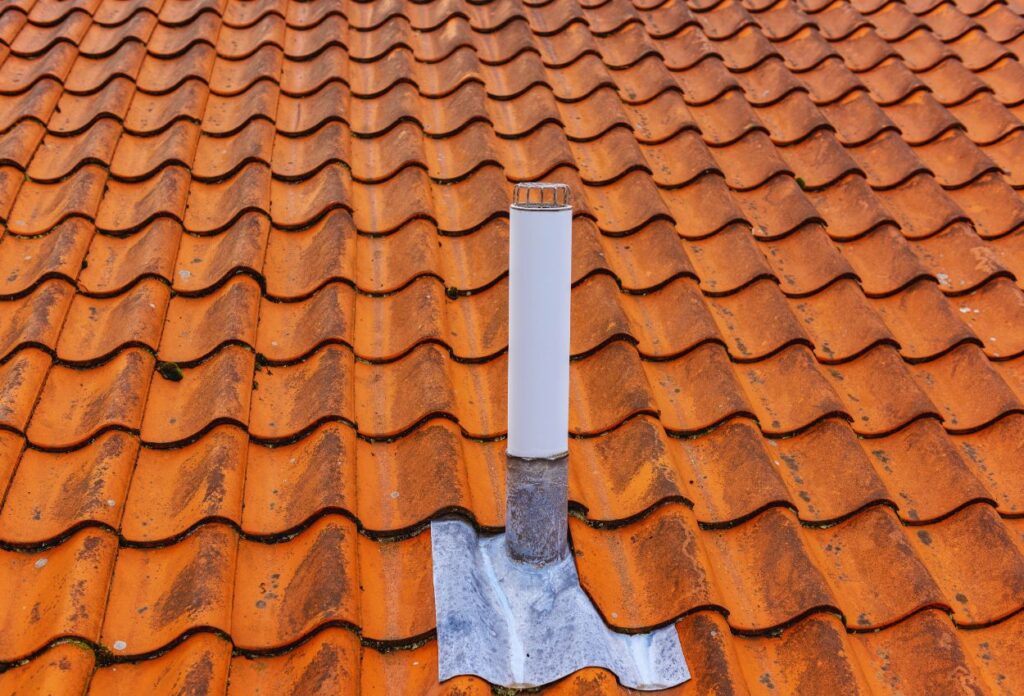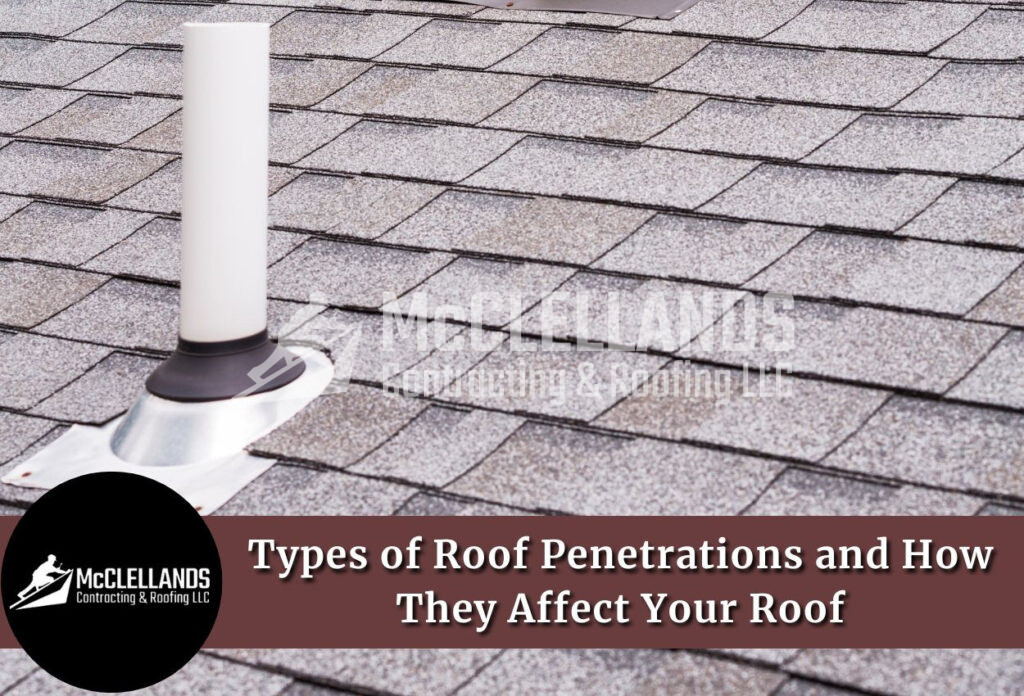Roof penetrations are an important part of your roofing system. From chimneys to vents, these features aren’t just random additions, they serve as functional components to your roof. Although the term might sound concerning, roof penetrations are carefully planned openings that play a big role in your home’s functionality, comfort, and safety.
As Pennsylvania’s dedicated roofers, we understand that it is important to know about the different parts of your roofing system. In this article, we will discuss all about roof penetrations, including what they really are, why they are important, types of roof penetrations, and more.
What Are Roof Penetrations?
So basically, a roof penetration is anything that passes through your roof’s surface. Every home has several roof penetrations, although the number and types can vary depending on your home’s design and systems. These intentional openings serve specific purposes, from helping your home ventilate properly to ensuring your plumbing works correctly.
New homeowners might wonder if having openings on their roofs is safe. When properly installed and maintained, roof penetrations are completely secure and necessary for your home. However, it’s important to understand how they work and what maintenance they require to keep your home protected.

Why Your Home Needs Roof Penetrations
Your home relies on various systems for comfort and safety, and many of these systems require penetrations to function properly. For example, your plumbing system needs vent stacks to maintain proper pressure and allow sewer gases to escape. Without roof penetrations, you could experience serious plumbing issues and potentially dangerous gas buildup in your home.
Similarly, your attic requires proper ventilation to prevent moisture accumulation and regulate temperature. This is why you’ll find various types of roof penetrations, such as attic vents and exhaust fans. These openings work together to create a healthy environment in your home while protecting your roof’s structural integrity.
What Are The Different Types Of Roof Penetrations?
So now that you understand roof penetrations and why are they important, we will get into the main section of the article: common types of roof penetrations. Knowing these types can help you better maintain your home.
#1 Chimneys and Exhaust Vents
Your chimney is perhaps the most noticeable roof penetration type. Whether constructed from brick, stone, or metal, chimneys serve as important pathways for smoke and gases to exit your home safely. For homes with gas fireplaces, you might have a smaller vent stack instead of a traditional chimney, but the principle remains the same.
An important feature you might not know about is the roof cricket. According to building codes, any chimney or roof penetration wider than 30 inches requires a cricket installation on the ridge side. This specially designed structure helps divert water around the chimney, preventing potential leaks and water damage.
#2 Plumbing Vent Stacks
Every home needs plumbing vent stacks, which are pipes that extend from the roof. These important roof penetrations serve multiple purposes.
First, they help maintain proper pressure in your plumbing system, prevent water from being siphoned from drain traps, and allow sewer gases to escape safely.
Without proper plumbing vents, you might experience slow drains, gurgling sounds, and unpleasant odors in your home.
#3 Attic Ventilation Systems
Your attic needs proper airflow to maintain indoor temperatures and prevent damage efficiently, which is why you’ll find several types of ventilation roof penetrations. These might include box vents, turbine vents, or powered attic fans.
Each type of vent plays a specific role in maintaining proper attic temperature and moisture levels, which is crucial for your roof’s longevity and your home’s energy efficiency.
#4 Skylights and Sun Tunnels
Skylights are larger roof penetrations that bring natural light into your living spaces. They come in different styles, including fixed skylights that don’t open, vented skylights that provide additional airflow, and tubular skylights (sometimes called sun tunnels) that work well in smaller spaces. While skylights add value and beauty to your home, proper installation is very important to prevent leaks and maintain energy efficiency.
#5 HVAC Components
Your heating, ventilation, and air conditioning system might require several roof penetrations. These include exhaust vents for heating systems and lineset roof penetrations for air conditioning units.
Commercial roof penetration requirements often include larger HVAC systems, which require special attention to weight distribution and waterproofing.
#6 Electrical Conduits
Electrical conduits are simply tubes that protect wires, just like tunnels protect things that pass through them. These tubes keep you safe from getting shocked, prevent fires, and make sure the wires inside don’t get damaged.
Instead of having messy wires all over the place, conduits keep everything neat and tidy. However, you need to make sure they’re sealed properly so water can’t get in. The best part about using these protective tubes is that if something goes wrong with your electrical system, you can easily find and fix the problem since you know exactly where all the wires are.
#7 Satellite Dish
Homes have a satellite dish on their roof to receive TV signals. Most dishes are held up by a three-legged stand or a metal bracket, which means putting holes in your roof to keep it steady.
The tricky part is that these holes can let water leak into your home if they’re not set up correctly. Just like any hole in your roof, water can sneak in around the satellite dish if you’re not careful.
To stop leaks, you need to make sure the dish is tightly attached and that the waterproof seals around it are in good shape. Think of it like sealing a boat – if there’s even a tiny gap, water will find its way in. That’s why it’s really important to use good waterproofing materials and check them every now and then to keep your roof dry and leak-free.
#8 Solar Panels
Solar panels are one of the most common types of roof penetrations we see nowadays. While these panels are amazing at making clean power from the sun, putting them on your roof needs careful consideration.
One big problem with this roof penetration type is that most solar companies who install them know a lot about panels but not much about roofs. That’s why it’s super important to talk to a roofer first before anyone starts drilling holes in your roof.
These panels, like other roof penetrations, can cause trouble:
First, they’re pretty heavy and need to be firmly attached to your roof. If your roof is already weak or if water sneaks in around where the panels are attached, it can cause the wood underneath to rot and get damaged.
This is different from other types of roof penetrations because solar panels cover a much larger area and need more attachment points than vents or chimneys.
Also Read: Do Roofing Nails Need To Penetrate The Roof Deck?
Call McClelands Contracting and Roofing, LLC For Professional Roofing Services In Pennsylvania
At McClellands Contracting and Roofing, LLC, we understand the important role that roofs play in your property. We have an entire team of professional roofers who have the right expertise and knowledge to work on different types of roofs.
We are a trusted choice for roofing services in Pittsburgh, and the surrounding areas in Pennsylvania. To know more or to get a custom quote, feel free to call us at (412) 353-5660.
Frequently Asked Questions
A. While it might seem like a good idea to minimize roof penetrations, it’s important to remember that many of them serve essential functions like ventilation. Completely eliminating them can lead to serious issues such as moisture buildup, poor indoor air quality, and fire hazards.
A. Signs of a poorly sealed roof penetration include water stains on your ceiling or walls, mold growth in your attic or around the penetration, and visible damage to the flashing or sealant. If you notice any of these signs, it’s crucial to have a professional inspect and repair the issue to prevent further damage.
A. It’s recommended to inspect your roof penetrations at least twice a year, especially before the rainy and winter seasons. Look for signs of damage, such as cracks, missing or loose flashing, or gaps around the penetrations. Promptly addressing any issues can prevent costly repairs in the future.
A. While you can attempt to seal minor issues around roof penetrations yourself, major repairs or installations should be handled by a professional roofer. They have the expertise and tools to ensure the job is done correctly and safely.
A. To seal roof penetrations, you’ll need roofing cement or sealant, flashing, and tools like a utility knife and caulking gun.
First, clean the area around the penetration to remove debris. Install flashing, which redirects water away from the penetration. For pipes and vents, use pre-formed boots or metal flashing. For chimneys and skylights, opt for step flashing or specific kits.
Finally, seal the flashing edges with roofing cement or sealant to prevent water intrusion. Always wear safety gear, especially when working on steep roofs.

